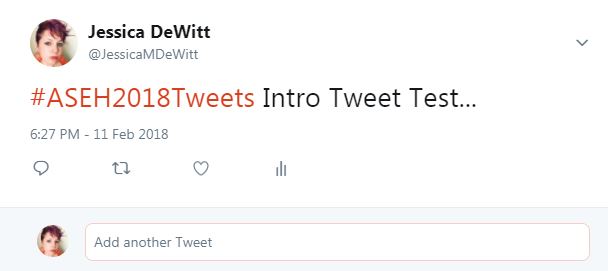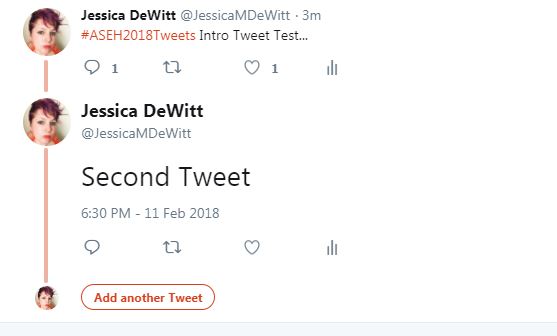(Many thanks to Andrea Eidinger and Krista McCracken who organized the Beyond 150 Twitter conference and created a basis on which to build other Twitter conferences, such as #ASEH2018Tweets. This guide is based closely on and borrows from the Beyond 150 Presenters’ Guide.)
#ASEH2018Tweets Presenters’ Guide
First, you need to sign up for a Twitter account, which you can do easily at www.twitter.com.
-This guide assumes that you have a basic familiarity with Twitter, but if you do not, please go here for a short guide to Twitter for historians.
Once you have set up your Twitter account, make sure that your account is not private and that your tweets are not protected, at least for the duration of the conference. If your account is private, others will not be able to see your presentation.
Where to start:
Each individual is responsible for presenting their own paper from their personal Twitter account. However, the @ASEHGradCaucus account will introduce each paper. The @ASEHGradCaucus, @ASEHResources, @NiCHE_Canada, and @NiCHE_NS will also retweet the first tweet of each paper and the resultant Twitter moments, respectively.
Drafting Your Tweets:
It is strongly recommended that you plan your tweets ahead of time in a Word Document or similar program.
How to Tweet Your Paper
Each paper will be allocated a thirty-minute time-slot. Participants will present their papers in the first fifteen minutes and the second fifteen minutes are intended for discussion and questions. That said, here are a few things to keep in mind about tweeting your paper:
- Participants are allowed between 8 to 10 tweets for their conference paper.
- These tweets can be text-based (within the 280-character limit), consist of slides and/or graphics, or combine both approaches. Links are also welcome.
- We recommend that you space out your tweets. You should try to aim for one tweet per minute or minute and a half.
- The first tweet in the thread *MUST* contain the conference hashtag #ASEH2018Tweets. We also recommend using #ASEH2018 (main conference hashtag), #envhist (general environmental history hashtag), and any other relevant hashtag the presenter might want to choose.
- Your very first tweet should be the title of your presentation.
- Your last tweet should include a link to additional resources/reading or a place where folks can learn more.
Formatting Your Tweets
All presentations must be presented in one Twitter Thread.
To thread your tweets:
- Send your first tweet with your title, opening information, and required hashtag(s).
- Reply to that Tweet
- Twitter recently made tweet threads easier to create
1. First Tweet of Presentation:
2. Click on “add another tweet” and enter your second tweet.
3. Continue “adding another tweet” until your presentation is complete!
Making Images Accessible
“We encourage presenters to tweet images and slides as part of their presentations. However, we also encourage participants to include image descriptions to make these images accessible. When you Tweet photos using the Twitter app for iOS or Android, or via the main Twitter website, you have the option to write a description of the images so the content is accessible to people who are visually impaired. Twitter has a handy outline of how to include image descriptions to help you get started.”
Interacting with Others
Since this is a conference like any other, we would encourage you to interact with other people as much as possible! There are several ways that you can do this.
- Check out the program (TBD) and follow some of the presenters on Twitter
- Follow the ASEH Graduate Caucus Twitter account, @ASEHGradCaucus, and the other sponsoring accounts, @NiCHE_Canada, @ASEHResources, and @NiCHE_NS
- Follow the official hashtag #ASEH2018Tweets
- Talk about the conference and the presentations you’d most like to see, including shout-outs to those presenters using their Twitter handles and the conference hashtag.
- Retweet your favorite parts of each presentation
- Ask questions
Feature Photo: Riverside by Owen Allen.



